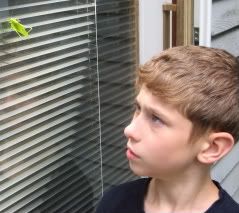
When you shop at library book sales, where often children's books are 25 to 50 cents each, you pick up a lot of books that
might be interesting. As it turns out, by serendipity I have found a surprisingly high number of really great science books published in the 1950's and 1960's. Perhaps only the better written or more popular books survive, or maybe it was a heyday for children's science, or possibly books have been dumbed down today, or it could be that I have not looked at enough modern science books; I don't know. All I know is that some of my best science books are from this era. Even searching "juvenile physics" or "juvenile chemistry" in the library catalogue, which lists results by publication date, shows that the older books seem to be the more interesting ones.
Some of the gems I have found include:
Authors like Jeanne Bendick, Millicent Selsam, Franklyn Branley, and Jerome Meyer.
Series like the
How and Why Wonder books of Grosset & Dunlap,
AllAbout books from Random House, the Golden Library of Knowledge, and Let's-Read-and-Find-Out Science (still published today.)
Oddities like
Arnold Roth's Crazy Book of Science ('71), with its cartoons and funny stories that make information memorable, and
Our Wonderful Earth by Herbert Townsend that introduces geology and earth science, natural science, and world culture to young children all in one book. Even classic authors with a single science title, like Holling C. Holling's
Pagoo and Virginia Lee Burton's
Life Story.
Of course you have to stick basic information, otherwise the books are hopelessly dated--though you can find some interesting historical information. For example, in
The Wonder of Light by Hy Ruchlis, I found out that housewives had hung clothes to dry because of UV light's germicidal power and that special UV lamps were used in hospital operating rooms to kill harmful germs. "A moderate amount of exposure to ultraviolet light is healthful," he states because it creates vitamin D. We now know how harmful UV rays are, though, so we put vitamin D in our milk and took those lights out of the operating room!
On the other hand, science history books are very informative; they were much more common and interesting than they are now.
Clocks, Calendars and Carrousels by John Navarra and
A Short History of Science and Scientific Thought ('49) by F. Sherwood Taylor are two excellent examples.
Many contemporary books seem to have more interest in advancing political agendas than advancing scientific ideas, which leads to a decrease in quality. Whether it's making Christians look bad, or making sure something relating to Evolution or the age of the earth is in
every book, or trying to be more "cool" than informative, or dumbing down the contents...well, it dilutes the book pool. Still, we have authors like Gail Gibbons and Robert Wells; series like Magic School Bus, One Small Square, and Kids Can!; other gems like
Tibaldo and the Hole in the Calendar by Abner Shimony,
Galileo for Kids by Richard Panchyk, and
How to Think Like a Scientist by Stephen P. Kramer. I'll be writing more about authors and series in future posts; keep an eye on my reviews on Shelfari for other great science titles.
 For science this winter and spring, we are using Blood and Guts: A Working Guide to Your Own Insides by Linda Allison. This is A Brown Paper School book, a series that also includes some great math titles like Math for Smarty Pants, The I Hate Mathematics! Book, and The Book of Think.
For science this winter and spring, we are using Blood and Guts: A Working Guide to Your Own Insides by Linda Allison. This is A Brown Paper School book, a series that also includes some great math titles like Math for Smarty Pants, The I Hate Mathematics! Book, and The Book of Think. I am pairing this up with The Body Book by Donald Silver. This book is filled with reproducible pages to be used to make large organ models. This book better covers anatomy, especially if you decide against dissection. It has more activities and some physiology as well.
I am pairing this up with The Body Book by Donald Silver. This book is filled with reproducible pages to be used to make large organ models. This book better covers anatomy, especially if you decide against dissection. It has more activities and some physiology as well.























 We have come across some interesting caterpillars crawling around our backyard this fall. This first one looks to be a
We have come across some interesting caterpillars crawling around our backyard this fall. This first one looks to be a 
















 I actually needed a few extra small struts--these, too, maintain the golden ratio in relation to the other struts. I didn't have enough struts to make the second wing.
I actually needed a few extra small struts--these, too, maintain the golden ratio in relation to the other struts. I didn't have enough struts to make the second wing.




